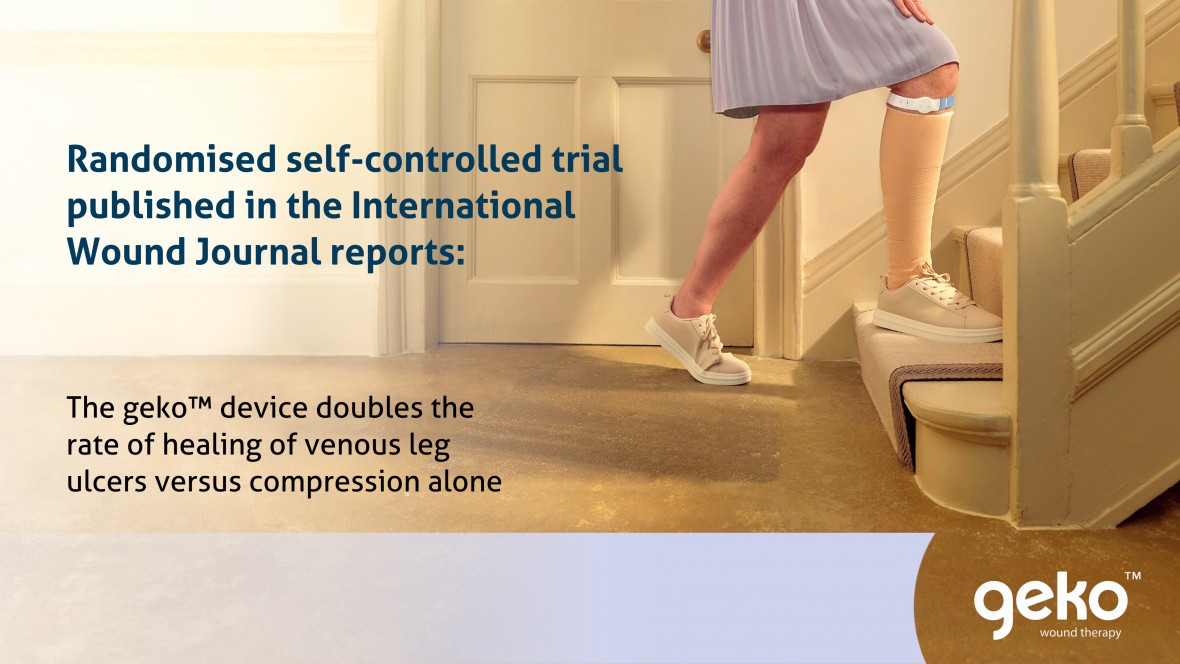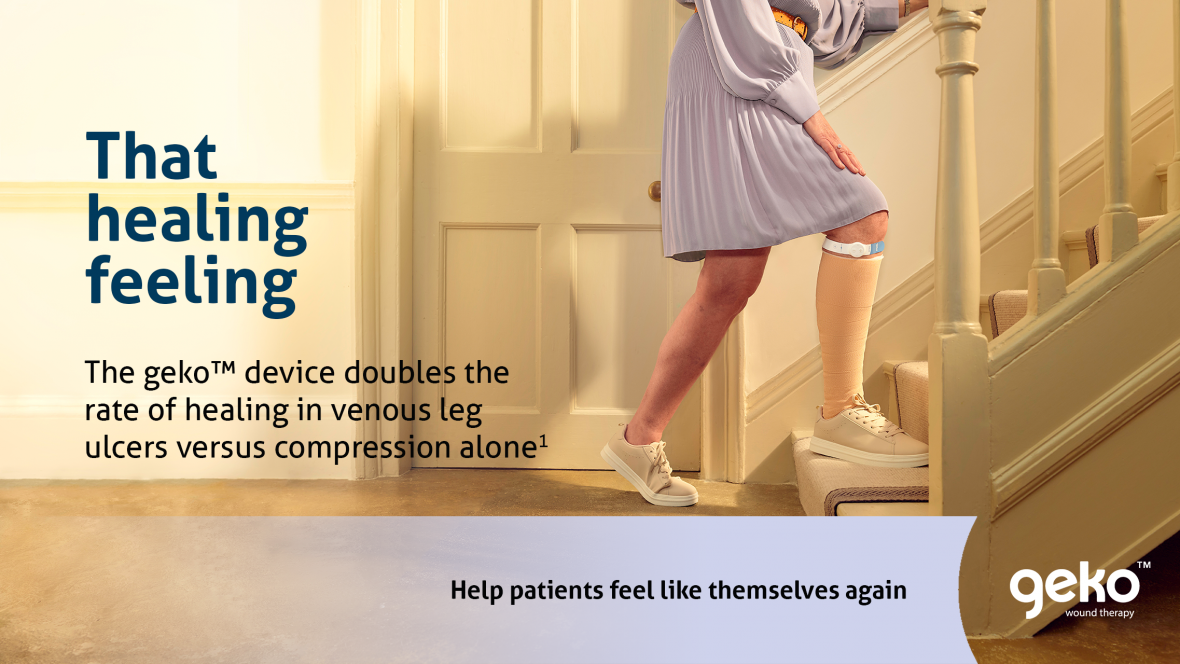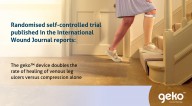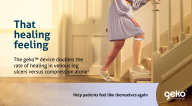Treatment offers new hope for patients with long-standing wounds
- Sky Medical Technology Ltd announces publication of a multi-centre randomised self-controlled trial (RCT) in the International Wound Journal.
- The study compared standard of care (SoC) with and without the geko™ device in patients with hard-to-heal venous leg ulcers (VLUs).
- Results show the geko™ device, combined with multi-layer compression doubles the rate of healing vs. compression alone1.
- The study is the first RCT to show a statistically significant increase in the rate of healing in VLU patients treated with an advanced adjunctive neuromuscular electrostimulation device (geko™).
- VLUs affect one in 500 adults in the UK2, costing the national healthcare system around £2 billion annually3.
- Worn at the knee, the wearable geko™ device, a neuromuscular electrostimulator, increases venous, arterial and microcirculatory blood flow, transporting oxygenated blood to the wound bed accelerating wound healing.
UK-based medical device manufacturer Sky Medical Technology (Sky) today announces the International Wound Journal has published the company’s landmark multi-centre randomised self-controlled trial (RCT). The study compared standard of care (SoC) with and without the geko™ device in patients with hard-to-heal venous leg ulcers (VLUs) and reports an acceleration in the rate of healing by more than double in patients treated with the geko™ device versus SoC alone. The results offer new hope to patients suffering long-standing chronic wounds.
The study1 is the first RCT to show a statistically significant increase in the rate of healing of VLUs treated with an advanced neuromuscular electrostimulation device (the geko™ device), adjunctive to standard of care.
“As a clinician in wound care, especially when managing patients with chronic wounds, the ultimate goal is improvement in healing rates. The results of this randomised self-controlled trial are extremely impressive and are also borne out in our direct experience of real-world use. Non-healing VLUs stop patients living their lives and robs them of hope. The geko™ device consistently accelerates VLU healing in the patients I treat.” comments Agnes Juguilon Collarte Tissue Viability Specialist Nurse Lead, Inner Northwest Division (Central London, Hammersmith & Fulham and West London).
Approximately 3.8 million adults in the UK suffer with a wound4. Many are hard-to-heal and, despite following best practice, wound healing can be prolonged or often never achieved, with more than 50% of VLUs failing to heal in 12 months4. Patients experience pain, anxiety, altered body image and isolation, leaving many without hope of improvement, suffering wound infections and recurrence.
The financial burden of non-healing wounds on hard pressed healthcare systems is also huge, higher than for cancer and cardiovascular disease. The annual NHS cost to manage wounds is £8.3 billion annually, £5.6 billion of which is the management of wounds that fail to heal4. VLUs affect one in 500 adults in the UK costing the NHS over £2 billion annually2, 50% of which remain unhealed4 – a number that is set to rise5.
About the RCT
The study, a multi-centre self-controlled trial, randomised patients with hard-to-heal VLUs, each acting as their own control. The primary efficacy endpoint was a comparison of the rate of wound margin advance (WMA), a powerful predictor of wound healing, during a four-week treatment period where the geko™ device was worn for 12 hrs per day alongside SoC, compared to WMA during a four week period where the patient received SoC only.
The geko™ device is a small-in-size, self-adhesive, wearable neuromuscular electro stimulator that is applied to the surface of the skin just below the knee, over the head of the fibula bone. It delivers a gentle electrical pulse, once per second to the common peroneal nerve, activating the calf and foot muscle pumps, increasing venous, arterial, and microvascular flow, effectively replicating the effects of exercise.6
The study results show that adding the geko™ device alongside SoC, led to a statistically significant two-fold acceleration in the rate of VLU healing (p=0.016), as measured by WMA compared to a 4-week period of compression alone. Analysis of the percentage area reduction (PAR) also showed a two-fold acceleration in the rate of healing (p=0.011), in contrast to compression alone, which maintained the same rate of healing throughout the run-in and treatment phases of the study1.
The geko™ device was also reported as well tolerated with 94% patient concordance1.
Patients receiving the geko™ device also reported better outcomes in pain reduction, plausibly reflected in the accelerated reduction in wound size1. Patients randomised to geko™ were also more likely to heal completely at the 12-weeks follow-up, than those randomised to SoC alone1. It is also worth noting the study continued throughout the pandemic, despite new COVID-19 protocols, indicating the ease and simplicity of the treatment.
Commenting on the clinical trial, Kieron Day, Sky Head of Clinical Studies, says: “We are extremely pleased with the highly positive results and grateful for the efforts of the clinical trial participants and investigators. A hallmark of the study is the WMA and PAR metrics that allowed a self-controlled study model to distinguish between the relative efficacies of the treatment regimens more rapidly, with greater sensitivity and with fewer subjects than a conventional RCT cohort model. RCTs using complete healing as the endpoint are seldom powered to be successful, owing to patient clinical diversity under a study7. Overall, I believe this trial may be considered to be a landmark study with an unparalleled effect size for a medical device.
Fiona Young, Sky Wound Care Business Director, comments: “These outstanding results are pivotal to placing this much anticipated data into the hands of our fast-expanding network of UK tissue viability nurses (TVNs) and international wound care specialists eager to embrace a transformative innovation able to increase the rate of healing. Ideal for home use and easy to fit, the geko™ device is a seamless addition to the current VLU pathway, empowering patients to both self-care, without disruption to daily routines, and to share-their-care with family members and healthcare professionals – reinforced by the high concordance rate of 94% reported in the study.”
Fiona adds: “The geko™ device is commercially available in the UK with regulatory approval granted in a growing number of international markets, with work to gain the necessary clearance to access the North American market advancing. We encourage early access to the geko™ device through our Partner-With-Us program. Please follow this link for details and to contact us.”
Bernard Ross, Sky Medical Technology’s Founder and CEO, comments: “We are delighted to have completed this landmark study which further validates geko™ device effectiveness in reporting a doubling of the rate of VLU healing, in a market that has seen surprisingly little real innovation in SoC over 20 years. Gold standard multi-layer compression can be effective, particularly in less complex and smaller wounds, but even in these patents is too often associated with low patient adherence. The success of the geko™ device in increasing the rate of SoC VLU healing is a critical step in bringing MedTech innovation to VLU patients around the world and to modernising standard of care – and cements our commitment to the streamlining of wound-care through evidence-based clinical efficiency for better patient outcomes.”
References
1. Bull, RH, Clements, D, Collarte, AJ, Harding, KG. The impact of a new intervention for venous leg ulcers: A within-patient controlled trial. Int Wound J. 2023; 1- 9. doi:10.1111/iwj.14107
2. https://www.nhs.uk/conditions/leg-ulcer/
3. Phillips, CJ, Humphreys, I, Thayer, D, et al. Cost of managing patients with venous leg ulcers. Int Wound J. 2020; 17: 1074– 1082. https://doi.org/10.1111/iwj.13366
4. Guest JF, Fuller GW, Vowden P. Cohort study evaluating the burden of wounds to the UK’s National Health Service in 2017/2018: update from 2012/2013. BMJ Open. 2020 Dec 22;10(12):e045253. doi: 10.1136/bmjopen-2020-045253. PMID: 33371051; PMCID: PMC7757484.
5. Probst, S., Weller, C.D., Bobbink, P. et al. Prevalence and incidence of venous leg ulcers—a protocol for a systematic review. Syst Rev 10, 148 (2021). https://doi.org/10.1186/s13643-021-01697-3
6. Tucker A, Maass A, Bain D, Chen LH, Azzam M, Dawson H, et al. Augmentation of venous, arterial and microvascular blood supply in the leg by isometric neuromuscular publication of the International College of Angiology, Inc. 2010 Spring; 19(1): e31-7.
7. Godwin M, Ruhland L, Casson I, MacDonald S, Delva D, Birtwhistle R, Lam M, Seguin R. Pragmatic controlled clinical trials in primary care: the struggle between external and internal validity. BMC Med Res Methodol. 2003 Dec 22;3:28. doi: 10.1186/1471-2288-3-28. PMID: 14690550; PMCID: PMC317298.





